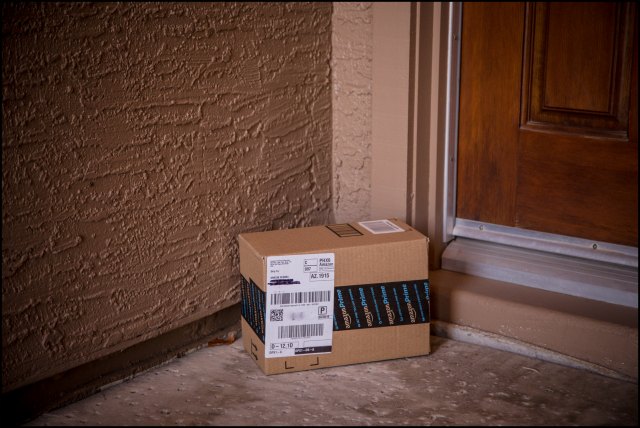Last year Amazon became the world's largest online retailer. Chances are good that if you have access to either a computer or smart phone, you have ordered something from Amazon. And it is delivered to your doorstep quickly - often within a day or two. Some cities now have same-day delivery.
Wow! How can they do that?
A friend invited me to go with her on an Amazon Fulfillment Center tour in Phoenix. She made the reservation for the tour over a year in advance and at last the day came!
The Amazon Fulfillment Center building is
The Phoenix facility we were at has small and medium-sized items. There are rows and rows and rows of shelving units with the aisles labeled with a number/lettering system. Our tour stopped on one of the aisles as the tour guide explained the process.
The first thing I noticed were lots of smallish (slightly larger than a shoebox) bins on the shelves filled with a seemingly random assortment of goods. One bin had a package of drinking straws, Disney cookie cutters, saline nasal spray, baby wipes, and measuring spoons. Of course, that's just what I could see without taking the bin out - there was lots of other stuff in the back of the bin.
Why were those particular items together in the bin? My mind was spinning trying to figure out what these items had in common. And I was getting nowhere fast.
And then the answer was given by our tour guide - there is no rhyme or reason to placing items in the bin, only that they fit in the bin. The entire operation is computer-controlled with employees doing the "stowing" and "picking."
When a product comes into the facility, the barcode on the item is scanned into their computer system and put in a cart. When the cart is filled, an employee called a "stower" scans a product with a hand-held scanner and the computer identifies which aisle and bin has room for that item. The stower finds the correct aisle and bin, makes sure the product will fit and then scans the product into that particular bin (all bins are identified with a barcode).
Okay, that explains the hodge-podge collection of items in the small bins. But how in the world do they find the items in a timely fashion when an order comes in? Wouldn't someone be running all over this massive facility just to find three or four items in a single order?
Filling an order is where employees called "pickers" come into play. Pickers are assigned an area and also issued a hand-held scanner. As orders come in, the computer lets pickers know which items to pick from a particular bin. When an item is taken from a bin, it is scanned "out" of the bin letting the computer know that bin now has room for another product. The computer knows how much space each product needs as well as how much space is in each bin, thus allowing the maximum amount of products in the least amount of space. There is no wasted space in the bin.
Once the picker scans an item out of a bin, it is placed in a large yellow bin which when filled, often with parts of multiple orders, are placed on a conveyor belt system and taken to the shipping area.
In the shipping area, all the parts of an order are put together in a box or mailing envelope by a "shipper" who places a label with a barcode on the package before placing it on a conveyor belt. From there it passes through scanners and machinery that generate a mailing label and adheres it to the package. It passes through yet another scanner to ensure the label is readable and in the right place on the package before being sent off to a truck to be shipped to the customer.
And all this happens very quickly.
As I was watching this amazing process in action, I wondered how someone came up with this process. It seems like a recipe for disaster for someone like me who craves order and logic, not randomness. But it works and I can't argue with that.
We enjoyed the tour and recommend it for anyone who wants to see what goes on behind the scenes. You can make a reservation for a tour of an Amazon Fulfillment Center near you (in six cities across the United States) here. But make it early - many are already completely booked through 2017! The 2018 schedule will be out "soon" or you can be put on a wait list for a cancellation.
And now I feel a "need" to browse through Amazon....


This comment has been removed by a blog administrator.
ReplyDelete